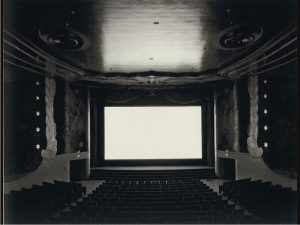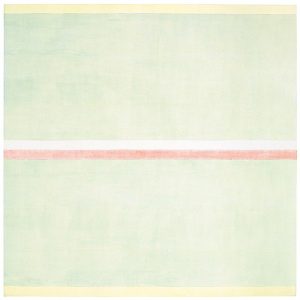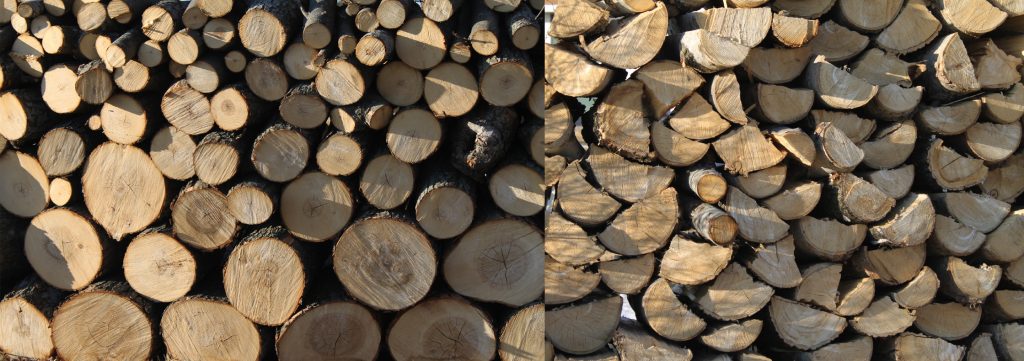 The landscape is now quiet, deep into winter, and I find myself staring at the sky, at the landscape and the wall, at nothing… The ocular equivalent of opening the shutter on a camera for an indefinite period of time and letting all the light in, much like the work of Japanese artist Hiroshi Sugimoto.
The landscape is now quiet, deep into winter, and I find myself staring at the sky, at the landscape and the wall, at nothing… The ocular equivalent of opening the shutter on a camera for an indefinite period of time and letting all the light in, much like the work of Japanese artist Hiroshi Sugimoto.  Sugimoto is well-known for his photographs of empty theater screens. He makes these pictures by setting up at the back of landmark movie palaces and exposing a single image for the duration of the film projected on screen. It is therefore nothing and everything contained in what seems to be pure light emanating from the screen. The resulting images are spectacularly quiet and unassuming. They are the opposite of what we might call the spectacle, veering more toward the meditative, similar to the way nature provides us a canvas of immense possibility. Especially Winter creating great expanses of monochromatic space calling to mind the surface and of an Agnes Martin painting.
Sugimoto is well-known for his photographs of empty theater screens. He makes these pictures by setting up at the back of landmark movie palaces and exposing a single image for the duration of the film projected on screen. It is therefore nothing and everything contained in what seems to be pure light emanating from the screen. The resulting images are spectacularly quiet and unassuming. They are the opposite of what we might call the spectacle, veering more toward the meditative, similar to the way nature provides us a canvas of immense possibility. Especially Winter creating great expanses of monochromatic space calling to mind the surface and of an Agnes Martin painting.  In such a space, it is possible to observe small things unmediated by external stimuli, many of which are not virtuosic or spectacular, more often they are the minutae of the quotidian, with indistinct boundaries; sometimes the prompts are inscrutable, like a stone creating a small rise under cover of snow, sometimes there is fleeting motion or sounds that pierce one’s reverie.
In such a space, it is possible to observe small things unmediated by external stimuli, many of which are not virtuosic or spectacular, more often they are the minutae of the quotidian, with indistinct boundaries; sometimes the prompts are inscrutable, like a stone creating a small rise under cover of snow, sometimes there is fleeting motion or sounds that pierce one’s reverie.
The spaces that nature creates and the spaces that a number of contemporary artists create often seem of a piece. Sugimoto’s photographs seem to create a zone of nothingness, which, if we allow for the possibility, prompt us to pour our own content into the void of the luminous screens that hover in the center of the frame. Such encounters invite us to ponder how works of art might prompt deeply personal meditations and we often do so in spaces of exhibition, such as museums or galleries. The curator and writer RoseLee Goldberg has noted that:
Museums today are being designed as places for gathering together large numbers of people and providing as much interactivity as possible, which is very different from going to museums in the ’70s, when the experience was more like going to a library or study hall. It was a place where you contemplated the art around you and talked in a whisper…
 As we know, in the contemporary era, art is often experiential, requiring the viewer to be more present than ever before. I often find myself framing visually provocative scenarios into questions about esthetics or other such formal considerations that telegraph ideas about art generally when we stroll through museums or galleries. In nature, or in the public sphere such delineations are more difficult and challenge us expand our thinking about art, both in theory and in practice.
As we know, in the contemporary era, art is often experiential, requiring the viewer to be more present than ever before. I often find myself framing visually provocative scenarios into questions about esthetics or other such formal considerations that telegraph ideas about art generally when we stroll through museums or galleries. In nature, or in the public sphere such delineations are more difficult and challenge us expand our thinking about art, both in theory and in practice.
I have been reading a lot of theory lately and those writers that most intrigue me seem to be working without a net; walking their propositions out to the edge of the world and stepping off into the space of the unknown.  In my recollections of circus performers flying through the air without a net, it seems a terribly anxiety-making thought. It is an apt metaphor for the kind of writing that Goldberg undertakes in the pages of her book, Performance Art: From Futurism to the Present. Writing (and reading) theory that is thick with philosophy and meaning is a different sort of dangerous. Such writing tends to be a quicksand of dense and difficult, almost utopian, propositions that engage history and practice in ways that the reader will find, at times, confounding, even maddening. However, in this era, that is is precisely what we should desire from those in our midst who take on the burden of thinking critically and deeply about the minutiae of contemporary creative practice.
In my recollections of circus performers flying through the air without a net, it seems a terribly anxiety-making thought. It is an apt metaphor for the kind of writing that Goldberg undertakes in the pages of her book, Performance Art: From Futurism to the Present. Writing (and reading) theory that is thick with philosophy and meaning is a different sort of dangerous. Such writing tends to be a quicksand of dense and difficult, almost utopian, propositions that engage history and practice in ways that the reader will find, at times, confounding, even maddening. However, in this era, that is is precisely what we should desire from those in our midst who take on the burden of thinking critically and deeply about the minutiae of contemporary creative practice.
Douglas Rosenberg
Chair, UW-Madison Art Department
